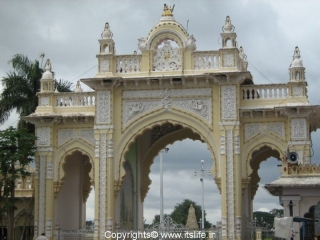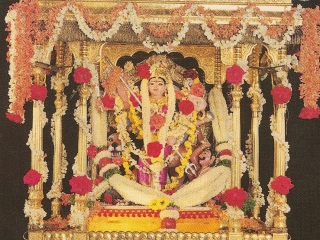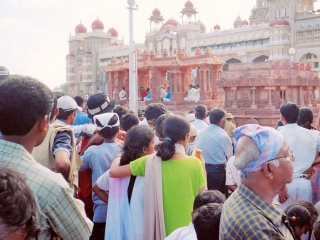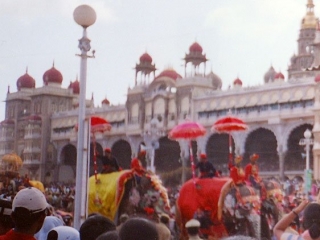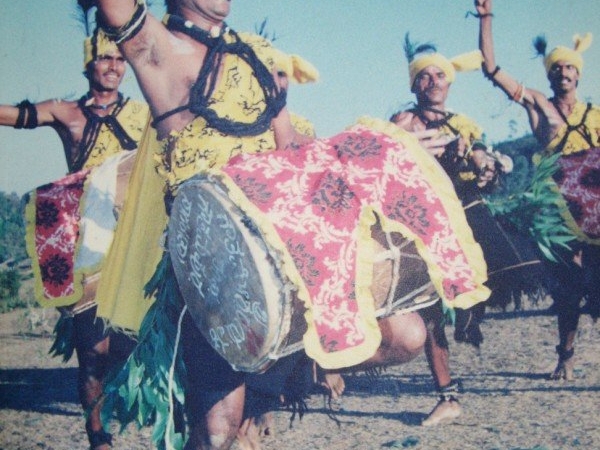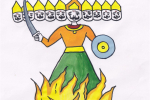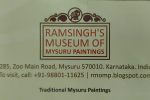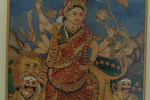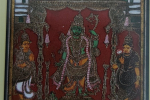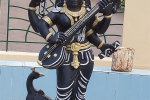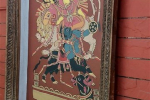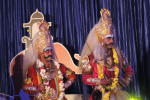Vijayadashami being the last day of the celebrations, a grand Jamboo Savari/procession passes through the streets of the city. The main attraction here is the idol of the goddess Chamundeshwari placed in the golden howdah on top of the Ambaari aane/elephant seat. The golden howdah is made using 80Kgs of gold. In the glorious past, when the kings ruled the state of Mysore, the kings used to sit in the howdah during the procession.
The procession will be inaugurated in a traditional way by worshipping the Nandi Dhwaja (a sacred pole) at the Balarama Gate of Mysore Palace. A 21 gun salute booms at the palace grounds.
Picture1 – Balarama Gate
The Chief Minister and the scion of the royal family, Srikantadatta Narasimha Raja Wodeyar in the palace grounds, shower flowers on goddess Chamundeshwari atop the ambari.
Picture2 – Golden Gowdah carrying the idol of goddess Chamundeshwari
The procession starts from the palace and proceeds towards Bannimantap. A distance of roughly 4 kilometers is covered and ends at the Banni/Shami tree in Bannimantap.
Picture3 – Mysore Palace
The procession consists of tableau, police bands, NCC (National Cadet Corps), police force, school children, mounted guards dressed in royal finery, folk artists and musicians. Decorated camels, horses and elephants also march in the procession.The pattada kudare/royal horse, pattada aane/royal elephant and pattada hasu/royal cow occupy prime space as they proudly walk in the procession.
Picture4 – Tableau in the procession
Silver carriage, band carriage and other traditional objects are also part of the procession. War equipments like cannon carriages are also showcased in the procession. The erstwhile kings used these to carry equipments like swords, shields and cannon carriages to the battlefields. Naupath and Nishane Elephants carry the erstwhile Mysore empire symbols.
Picture5 – Decorated Elephants
Lakhs of people throng the route of the procession to catch a glimpse of the bygone era. The rural people enjoy it the most and plan days ahead to witness the “nota”/procession along with their family.
A brief Description of some of the cultural troupes commonly participating in the procession is given below:
- Beesu Kamsale Dance: After testing Billayya and Karayya in sword magic, Male Mahadeshwara dances with joy, waving his Kamsale giving birth to this art form. This war strategy dance form is accomplished by concentration and constant practice.
- Dollu Kuntiha: Legend – Demon Dollasura worshiped Shiva devotedly and Lord Shiva appeared before him and asked him to ask for a boon, Dollasura asked that he should be able to swallow Shiva himself. The boon was granted and Dollasura swallowed Shiva. Shiva started growing big. The asura unable to bear the pain pleaded Shiva to come out. Shiva tore open the demon thus killing him and came out; Shiva used the skin of the asura to make a dollu/drum and gave it to the ganas/rustics to play it.
- Donne Varase: It is a sort of acrobatic martial art. A heavy ball is attached to a long staff held at the center and revolved to hit the person.
- Goravara Kunitha: Gorava is the die-hard devotee of God Mylaralinga. They wear a blanket over their clothes and a peta/turban on their head and colorful beads on their neck.
- Hejje Kunitha/Step Dance: This dance is performed during Moharram festival in North Karnataka.
- Jaghalige Mela: Jaghalige is a very big drum, of the size and shape of a wheel of bullock cart; it produces immense sound. It is used in villages of North Karnataka.
- Karaga: This is a dance form from Madikeri/Coorg devoted to Shakti Devatas/Gods of power.
- Kolata: This form of dance requires the dances to hold a stick in each hand and dance to the rhythm of music. The clanking of the sticks itself makes a unique rhythm. There are 59 types of kolata like suttukolu, Datukolu and Jadekolu.
- Nadaswara: Playing pipe or Nadaswara is a must in any auspicious function. It is popularly known as “Volaga” in Kannada, which means pipe.
- Nandi Dhwaja Dance: Nandidhwaja dance is enacted in religious utsavas symbolizing victory. It symbolizes Veerbhadra’s victory on his opponent Dakshabrahma, represented by a cultural hero and victory of kings of Yaduvamsha.
- Pooja Dance: The Utsavamoorthi/small idol is carried on the dancer’s head decorated by flowers and colored clothes. This is common in Mandya district.
- Veerabhadra Dance: Veerabhadra is one of the Ganas of Lord Shiva. He kills Dakshabrahma. The raging dance of Veerabhadra is thrilling.
- Veeragase: Dakshabrahma condemns Shiva because Shiva does not get up to honor Dakshabrahma who was performing a sacrifice. The infuriated Shiva creates Veerabhadra through his third eye on his fore head, and sends him to Dakshabrahma. Terrific in his dance, the angry Veerabhadra comes to Dakshabrahma and cuts off his head. Veeragase is a dance of terror.
- Yakshagana: It is an art form of coastal area of Karnataka. It gives importance to dance and acting along with music. The art is famous for its attractive costumes and ornaments.
After the procession reaches Bannimantap, the Banni/Shami tree/Prosopis spicigera is worshipped with great devotion and it is believed that the tree blesses the devotees with shakthi/power.
